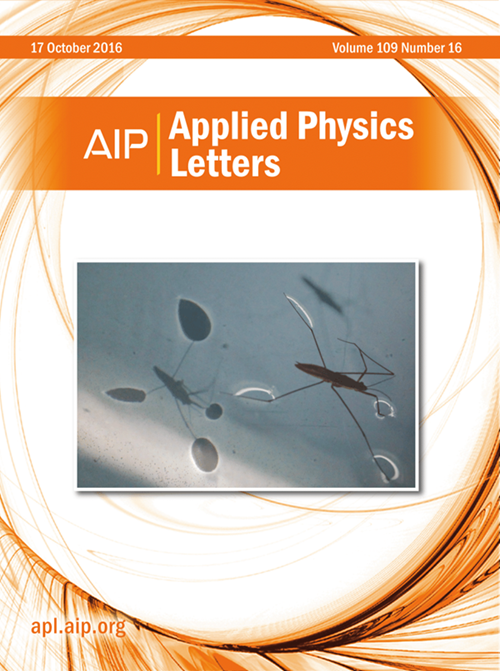MoS2–MoSe2 nanoflakes-based n–n heterojunction toward highly sensitive and selective room-temperature NO2 gas sensor
IF 3.5
2区 物理与天体物理
Q2 PHYSICS, APPLIED
引用次数: 0
Abstract
The present research reports the controlled fabrication of MoS2–MoSe2 hybrid nanostructures utilizing DC magnetron co-sputtering technique for highly selective and sensitive room-temperature (RT) NO2 detection. Among the optimized sensing thin films, the MoS2–MoSe2 sensor with a precisely engineered thickness of ∼350 nm demonstrates an exceptional sensor response of ∼61.3% toward 0.7 ppm NO2 at RT, coupled with a rapid response/recovery time of ∼77/87 s. This superior sensitivity of the MoS2–MoSe2 sensor is attributed to the abundant adsorption sites, the synergistic effects of MoS2–MoSe2 heterostructure, efficient charge transfer dynamics, and the unique n–n heterojunction band alignment, which collectively enhance carrier modulation and gas interaction kinetics. Additionally, the sensor delivers remarkable repeatability over 21 consecutive cycles, long-term operational stability exceeding 80 days, and outstanding selectivity toward NO2 against potentially interfering gases, underscoring its reliability for real-world applications. Thus, the MoS2–MoSe2 nanocomposite sensor emerges as a promising candidate for next-generation NO2 gas sensing, offering a robust platform for real-time air quality monitoring and environmental safety applications.基于MoS2-MoSe2纳米片的n-n异质结用于高灵敏度和选择性室温NO2气体传感器
本研究报道了利用直流磁控共溅射技术控制制备MoS2-MoSe2杂化纳米结构,用于高选择性和高灵敏度的室温(RT) NO2检测。在优化的传感薄膜中,精确设计厚度为~ 350 nm的MoS2-MoSe2传感器在RT下对0.7 ppm NO2的响应为~ 61.3%,并且快速响应/恢复时间为~ 77/87 s。MoS2-MoSe2传感器的优越灵敏度归功于丰富的吸附位点、MoS2-MoSe2异质结构的协同效应、高效的电荷转移动力学以及独特的n-n异质结带对准,这些因素共同增强了载流子调制和气体相互作用动力学。此外,该传感器在21个连续循环中提供了卓越的重复性,超过80天的长期运行稳定性,对NO2的选择性突出,可以抵抗潜在的干扰气体,强调了其在实际应用中的可靠性。因此,MoS2-MoSe2纳米复合传感器成为下一代NO2气体传感的有希望的候选者,为实时空气质量监测和环境安全应用提供了强大的平台。
本文章由计算机程序翻译,如有差异,请以英文原文为准。
求助全文
约1分钟内获得全文
求助全文
来源期刊

Applied Physics Letters
物理-物理:应用
CiteScore
6.40
自引率
10.00%
发文量
1821
审稿时长
1.6 months
期刊介绍:
Applied Physics Letters (APL) features concise, up-to-date reports on significant new findings in applied physics. Emphasizing rapid dissemination of key data and new physical insights, APL offers prompt publication of new experimental and theoretical papers reporting applications of physics phenomena to all branches of science, engineering, and modern technology.
In addition to regular articles, the journal also publishes invited Fast Track, Perspectives, and in-depth Editorials which report on cutting-edge areas in applied physics.
APL Perspectives are forward-looking invited letters which highlight recent developments or discoveries. Emphasis is placed on very recent developments, potentially disruptive technologies, open questions and possible solutions. They also include a mini-roadmap detailing where the community should direct efforts in order for the phenomena to be viable for application and the challenges associated with meeting that performance threshold. Perspectives are characterized by personal viewpoints and opinions of recognized experts in the field.
Fast Track articles are invited original research articles that report results that are particularly novel and important or provide a significant advancement in an emerging field. Because of the urgency and scientific importance of the work, the peer review process is accelerated. If, during the review process, it becomes apparent that the paper does not meet the Fast Track criterion, it is returned to a normal track.
 求助内容:
求助内容: 应助结果提醒方式:
应助结果提醒方式:


